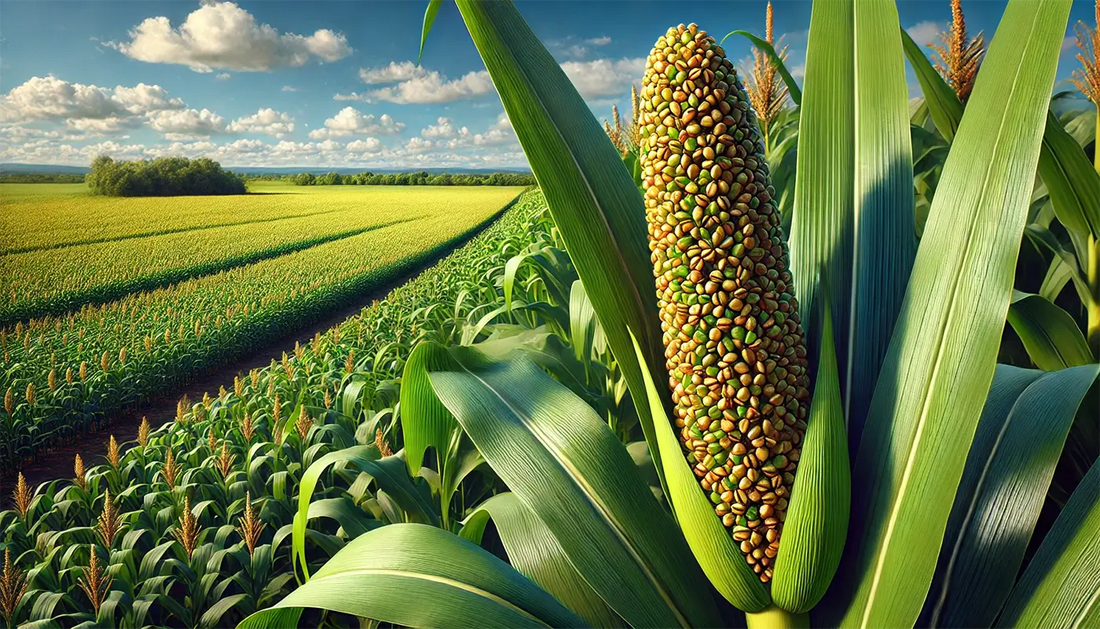
Why millets are the ultimate climate-resilient crop for a sustainable future
Millets, a climate-resilient crop, are a group of small-seeded grasses that have been cultivated for thousands of years in dry and semi-arid regions of the world. They are often considered a "climate resilient" crop due to their ability to tolerate extreme weather conditions, including drought, heat, and flood. In this blog, we will explore the various ways in which millets are a climate-resilient crop, and how they can play a role in promoting sustainable agriculture practices.
What are millets?
Millets are a group of small-seeded grasses. They include popular varieties like finger millet, pearl millet, and foxtail millet. These crops have been grown for thousands of years in Asia and Africa. They are staple foods for millions, providing essential nutrients and calories. Unlike many modern grains, millets are versatile and thrive in challenging environments. They are used in porridge, bread, and even drinks.
Millets as climate-resilient crops
One of the primary reasons why millets are considered a climate-resilient crop is their ability to withstand drought. Millets have a deep root system that allows them to access moisture from deeper soil layers, making them less dependent on external irrigation. This means that millets can still thrive and produce a good yield even in areas with low rainfall or limited access to irrigation.
Millets are also resistant to extreme heat, making them well-suited for growing in hot and arid regions. The plants have a high tolerance for high temperatures, allowing them to continue growing and producing a good yield even during hot spells.
In addition to their ability to withstand drought and heat, millets are also resistant to flood. The plants have a strong tolerance for standing water, allowing them to survive and continue growing even in areas prone to flooding. This makes millets a useful crop for farmers in areas prone to flooding or waterlogging.
Another reason why millets are considered a climate-resilient crop is their ability to fix nitrogen from the air, reducing the need for synthetic fertilizers. Synthetic fertilizers are a major contributor to greenhouse gas emissions, and the use of millets can help reduce the carbon footprint of agriculture.
The most drought tolerant and extremely hardy millets
The most drought-tolerant and extremely hardy millets include:
- Pearl Millet (Bajra): Pearl millet is a highly drought-tolerant crop that is native to the semi-arid regions of Africa. It has a deep root system that allows it to access moisture from deeper soil layers, making it less dependent on external irrigation.
- Finger Millet (Ragi): Finger millet is another drought-tolerant millet that is native to the dry regions of Africa and Asia. It is able to withstand extreme heat and drought and is often grown as a staple food in areas with low rainfall.
- Proso Millet: Proso millet is a hardy crop that is native to the dry regions of Asia and Europe. It is able to withstand drought and extreme heat and is often grown as a forage crop for livestock.
- Foxtail Millet: Foxtail millet is a drought-tolerant crop that is native to the dry regions of Asia. It is able to withstand extreme heat and drought and is often grown as a staple food in areas with low rainfall.
Why millets are a sustainable choice
Millets contribute to sustainable farming in several ways. First, they require fewer inputs. Millets grow without the need for synthetic fertilizers or pesticides. This is beneficial for the environment, as it reduces soil and water pollution. Growing millets is therefore friendlier to ecosystems.
Another sustainability factor is the low carbon footprint associated with millet production. Millets do not require large amounts of water, electricity, or fuel. Rice and wheat farming often involve heavy irrigation systems. Millets, on the other hand, are more naturally resource-efficient. Choosing millets helps reduce greenhouse gas emissions, supporting climate action.
In terms of biodiversity, millets are also a win. They grow alongside other crops without harming them. Farmers use millets as inter-crops in mixed farming systems. This kind of agricultural biodiversity is essential for reducing risks and maintaining healthy soil.
Nutritional benefits of millets
Millets are not only climate-resilient but also incredibly nutritious. They are rich in protein, dietary fibre, and essential vitamins and minerals. Millets contain high levels of magnesium, iron, and calcium. These nutrients are vital for preventing nutritional deficiencies, especially in rural areas. Compared to polished white rice or wheat, millets are whole grains that retain their bran and germ. This makes them high in fibre, which helps in digestion.
Millets have a low glycaemic index (GI). This means they release sugar into the bloodstream slowly, making them an excellent choice for people with diabetes. With diabetes rates soaring globally, millets are a healthy alternative that can help maintain stable blood sugar levels. Including millets in your diet can also help in weight management. Their high fibre content keeps you full for longer, reducing overeating.
The role of millets as climate-resilient crops and in food security
Climate change threatens the food security of millions of people. Droughts, heatwaves, and soil degradation are becoming more frequent. Millets can help mitigate these challenges. Their resilience to climate stressors makes them a reliable crop for farmers. When other staple crops fail due to extreme weather, millets still thrive. By including millets in agriculture, we can ensure a more stable food supply.
In many developing countries, farmers face a choice between risk and reward. Planting high-yielding crops like rice comes with a risk. Drought or delayed rains can destroy an entire harvest. Millets provide a safer alternative. They are dependable even when the climate is unpredictable. This makes millets an important crop for ensuring food security in vulnerable areas.
Millets and economic benefits for farmers
Millets offer economic resilience as well. Farmers who grow millets are less reliant on expensive inputs like irrigation systems and fertilizers. They can produce millets with fewer resources. Moreover, as the demand for healthy, sustainable foods increases, farmers can benefit from premium pricing. The global focus on sustainable agriculture has increased the market value of these ancient grains.
In India, for example, the government has recognized the importance of millets. It is providing incentives and subsidies to encourage millet cultivation. Many NGOs and international organizations are also promoting millet farming to empower small-scale farmers. This has a ripple effect in rural communities, creating stable incomes and improving livelihoods.
How millets support biodiversity
Agricultural biodiversity is key to resilience. Monoculture, the practice of growing one crop repeatedly, can lead to soil degradation and increased vulnerability to pests. Millets, by contrast, are often grown alongside other crops. They help maintain soil fertility and promote a healthy ecosystem. This biodiversity is beneficial for pollinators like bees, which play an essential role in food production.
Growing diverse crops also helps prevent pest outbreaks. Millets are less vulnerable to pests and diseases compared to monoculture crops like rice or wheat. This reduces the need for chemical pesticides. As a result, millet farming supports both environmental health and agricultural biodiversity.
Promoting millets for a sustainable future
Millets can play a significant role in building a sustainable future. Governments, NGOs, and consumers all have a role in promoting this crop. Governments can create policies that encourage millet farming and consumption. School meal programs can incorporate millets, introducing children to the benefits early. NGOs can work with farmers to provide education and training on millet farming techniques.
Consumers also have a role to play. By choosing millets over water-intensive grains, we support sustainable agriculture. Supermarkets and food companies can promote millet-based products. The rise in health-conscious eating trends has opened up opportunities for introducing millet into mainstream diets.
Conclusion: Millets as climate-resilient crops
Millets are more than just an ancient grain. They are a powerful tool for addressing some of our biggest challenges—climate change, food security, and sustainable development. Their ability to grow in difficult conditions, minimal resource needs, and nutritional benefits make them the ultimate climate-resilient crop. By promoting millets, we can take a step towards a more sustainable and resilient food system. So, the next time you think of healthy, climate-friendly grains, consider millets. They may be small, but their impact is mighty.
Image Courtesy: ACCENTERRA
Did you find this blog post helpful? Got ideas or questions? Join the conversation below! Your insights could help others too, so don’t hesitate to share!
Please note that all comments will be moderated before being published.
